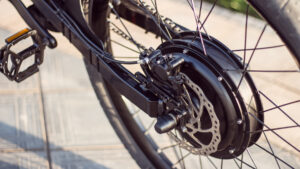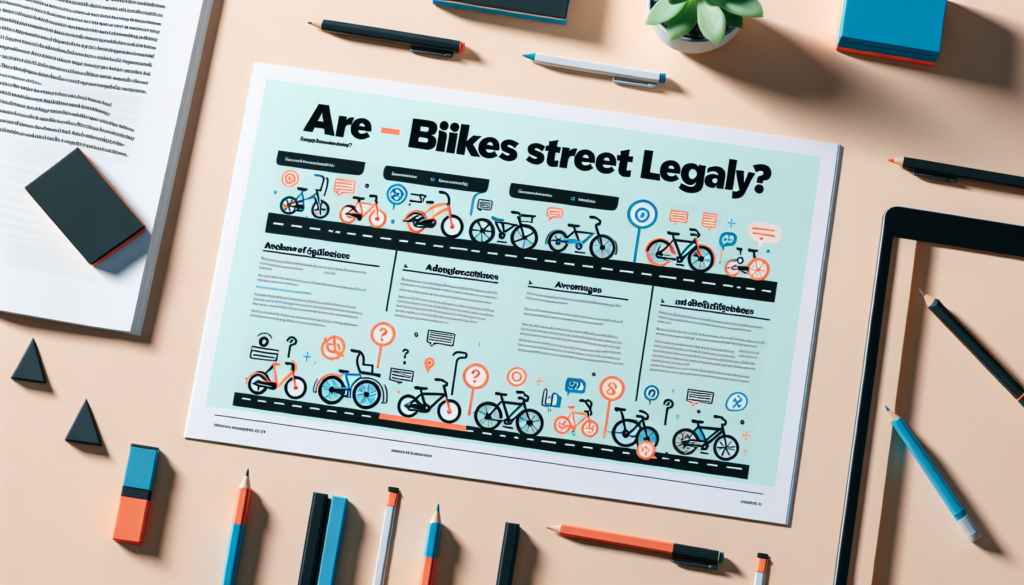You’re curious about the legality of ebikes on the streets, and you’re not alone. With the growing popularity of these electric-powered wonders, it’s important to know whether you can confidently hit the road on one. In this article, we’ll explore the regulations surrounding ebikes and find out if they have the green light to cruise the streets. So buckle up and get ready to discover if ebikes are indeed street legal!
Understanding Ebikes
What are Ebikes?
Ebikes, short for electric bikes, are bicycles that are equipped with a small electric motor to assist in propelling the rider forward. They are designed to provide a smoother and easier riding experience, especially when facing hilly terrains or strong headwinds. The electric motor is powered by a rechargeable battery, which can be charged at a regular power outlet.
Different Classes of Ebikes
Ebikes are classified into different classes based on their speed and power capabilities. These classes help determine the legality and regulations surrounding ebike usage. The four main classes of ebikes are Class 1, Class 2, Class 3, and Class 4.
Ebikes vs Regular Bicycles
While regular bicycles rely solely on human power for propulsion, ebikes provide an additional electric motor assist. This means that with an ebike, you have the option to pedal or use the electric motor, or even a combination of both. Regular bicycles require more physical effort and can be more challenging to ride uphill or over long distances, while ebikes offer more versatility and accessibility to riders of varying fitness levels and abilities.
Street Legal Categories
Federal Laws Regarding Ebikes
In the United States, ebike regulations are primarily determined at the federal level. According to federal law, Ebikes are classified as bicycles rather than motor vehicles as long as they meet certain criteria. The key regulations established by the Consumer Product Safety Act (CPSA) are that the motor should have a maximum power of 750 watts (1 horsepower) and should provide assistance only when the rider is pedaling. This means that the electric motor should not be capable of propelling the bike without any human input.
State and Local Laws
In addition to federal laws, individual states and local municipalities may have their own specific regulations regarding the use of ebikes on public roads and trails. It’s important to familiarize yourself with these rules, as they can vary significantly from one jurisdiction to another. Some states may have additional restrictions or require registration and licensing for certain classes of ebikes.
Speed and Power Limitations
To maintain their status as bicycles, ebikes are generally subject to speed and power limitations. Class 1 and Class 2 ebikes typically have a maximum assisted speed of 20 mph and are limited to 750 watts of power. Class 3 ebikes, on the other hand, can provide assistance up to 28 mph but are restricted to 750 watts as well. Class 4 ebikes, also known as mopeds, are subject to specific motor vehicle regulations and are not considered bicycles.

Close up of motor electric bike. Ebike bicycle environmentally friendly eco e-mountainbike transport. Healthy lifestyle
Classifying Ebikes
Class 1 Ebikes
Class 1 ebikes are equipped with a motor that provides assistance only when the rider is pedaling. The motor is limited to a maximum power output of 750 watts. These ebikes have a top assisted speed of 20 mph, providing a comfortable and efficient ride for commuting and leisure purposes.
Class 2 Ebikes
Class 2 ebikes come with an electric motor that can provide assistance even without the rider pedaling. The motor is still limited to 750 watts, but the ebike can reach a top assisted speed of 20 mph. Class 2 ebikes are popular among riders who may need occasional breaks from pedaling but still want the benefits of electric assistance.
Class 3 Ebikes
Class 3 ebikes have a higher assisted speed limit of 28 mph, while still complying with the 750-watt power limitation. To achieve this increased speed, Class 3 ebikes usually have a more powerful motor and are commonly used by commuters who want a faster way to get around town.
Class 4 Ebikes
Class 4 ebikes, commonly known as mopeds, are not considered bicycles under most regulations. They have a maximum power output above 750 watts and are capable of speeds exceeding 28 mph. These ebikes follow the regulations set for motor vehicles and typically require appropriate licensing, registration, and insurance.
Equipment and Safety Requirements
Lights and Reflectors
To ensure safety on the road, ebikes are usually required to have lights and reflectors. Just like regular bicycles, ebikes are required to have a white headlight that is visible from at least 500 feet away when riding at night. They should also have a red rear reflector and reflectors on both the pedals to enhance visibility.
Helmets
While helmet requirements for ebike riders vary depending on local laws, it is generally recommended to wear a helmet for safety. Wearing a helmet can significantly reduce the risk of severe head injuries in the event of a crash or fall.
Brakes and Tires
Ebikes are typically equipped with reliable braking systems to ensure efficient stopping power. Both front and rear brakes are required to be in good working condition. Additionally, tires should be in proper condition with sufficient tread depth for traction and grip.
Age and Licensing Requirements
Age restrictions and licensing requirements for ebike riders also vary depending on local regulations. In some areas, there may be no specific age restrictions, while others may require riders to be of a certain age to operate an ebike. Some jurisdictions may also require a driver’s license or permit for riding certain classes of ebikes.

Benefits and Limitations
Advantages of Ebikes
Ebikes offer numerous advantages for both commuters and recreational riders. They provide an eco-friendly alternative to traditional transportation methods, reducing carbon emissions and reliance on fossil fuels. Ebikes also make cycling more accessible to individuals with varying fitness levels or physical limitations, allowing them to cover longer distances with less effort. Additionally, the electric motor assistance can help reduce sweat and fatigue, making it a more comfortable option in hot or hilly areas.
Limitations of Ebike Usage
While ebikes offer many benefits, they also have some limitations. The primary limitation is the reliance on battery power. The range of an ebike is typically limited by the battery capacity, and riders may need to plan their routes accordingly to ensure they don’t run out of power. Additionally, ebikes tend to be heavier than regular bicycles due to the added components, which can make them more challenging to maneuver or carry up stairs.
Environmental Impact
One of the significant advantages of ebikes is their positive impact on the environment. By opting for an ebike instead of a car for commuting or short trips, you are reducing your carbon footprint and contributing to cleaner air quality. Ebikes have the potential to reduce traffic congestion and reliance on fossil fuels, ultimately leading to a more sustainable future.
Enforcement and Penalties
Enforcing Ebike Regulations
Enforcement of ebike regulations is primarily the responsibility of local law enforcement agencies. They have the authority to conduct inspections and enforce compliance with relevant laws and regulations. Police officers may monitor ebike riders for compliance with required safety equipment, speed limits, and adherence to traffic laws.
Possible Penalties for Noncompliance
The penalties for noncompliance with ebike regulations can vary depending on the severity of the offense and local jurisdiction. Riders who fail to follow regulations such as not wearing a helmet, riding without required equipment, or operating a non-compliant ebike may be subject to fines, warnings, or even confiscations of their ebikes.

International Regulations
Street Legality in Different Countries
Street legality of ebikes varies from country to country. Some countries have embraced ebike culture and have specific regulations in place to accommodate their use. Others may have stricter regulations or may not even recognize ebikes as legal vehicles. It is essential to research and understand the specific regulations and restrictions in each country before riding an ebike there.
European Union Regulations
In the European Union (EU), ebike regulations have been standardized to facilitate cross-border usage. EU regulations classify ebikes into three categories: Pedelecs, E-bikes with Throttle, and Speed E-bikes. Each category has specific requirements regarding maximum motor power, assisted speed, and age restrictions.
Global Ebike Standards
While there is no single global standard for ebikes, organizations such as the International Organization for Standardization (ISO) and the European Committee for Standardization (CEN) have been working towards establishing international standards for ebike safety and performance. These standards aim to ensure consistent quality and safety measures across different regions and manufacturers.
Advocacy and Future Developments
Advocacy for Ebike Legalization
Advocacy groups and organizations are actively working towards the legalization and promotion of ebikes as a viable mode of transportation. They seek to influence policymakers and decision-makers to create more favorable regulations and infrastructure to support ebike usage. These advocacy efforts aim to raise awareness about the benefits of ebikes and promote their adoption on a larger scale.
Changes in Laws and Regulations
Laws and regulations surrounding ebikes are continuously evolving as governments and lawmakers become more familiar with this mode of transportation. As the popularity of ebikes grows, it is likely that there will be changes to existing regulations to accommodate the needs of ebike riders. These changes may include updates to speed limits, power restrictions, and safety requirements.
Advancements in Ebike Technology
The ebike industry is experiencing rapid technological advancements to improve performance, efficiency, and user experience. Battery technology is improving, offering longer ranges and shorter charging times. Motors are becoming more powerful and quieter, while being integrated seamlessly into the frame design. As technology continues to evolve, ebikes will become more accessible, efficient, and enjoyable for riders of all backgrounds.

Frequently Asked Questions
Can I ride an ebike on the street?
Yes, you can generally ride an ebike on the street as long as it complies with local regulations regarding speed, power limitations, and safety requirements. It’s important to familiarize yourself with the specific laws in your jurisdiction to ensure you are riding within the legal parameters.
Do I need a driver’s license for an ebike?
In most cases, you do not need a driver’s license to operate an ebike. However, some jurisdictions may require licensing or permits for certain classes of ebikes. It’s important to check the regulations in your area to determine whether a license is required.
What are the speed limits for ebikes?
Speed limits for ebikes vary depending on the class of the ebike and local regulations. Class 1 and Class 2 ebikes generally have a maximum assisted speed limit of 20 mph, while Class 3 ebikes can reach a maximum assisted speed of 28 mph. Class 4 ebikes, or mopeds, follow motor vehicle speed limits and regulations. It’s important to adhere to the speed limits set by your local jurisdiction to ensure safe and legal riding.


